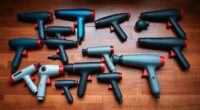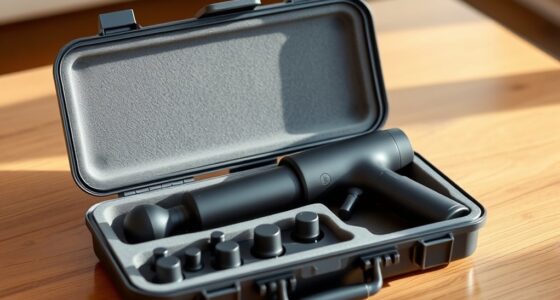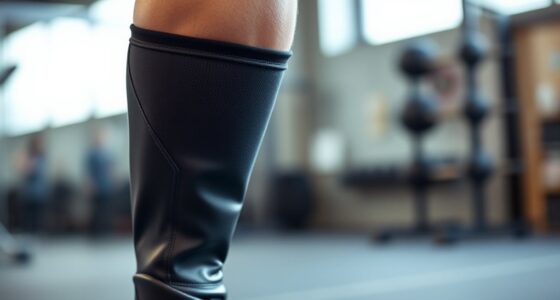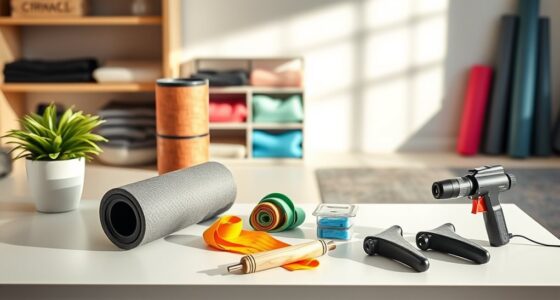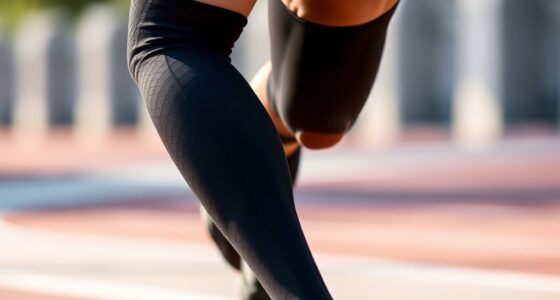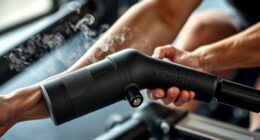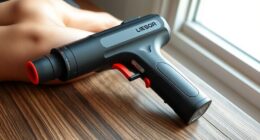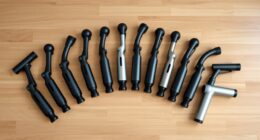Pneumatic leg massagers and compression boots both boost circulation and ease leg discomfort, but they serve different purposes. Massagers use gentle, customizable pulses to relax muscles and support recovery, making them ideal for daily use. Compression boots deliver intense, sequential pressure that mimics muscle pumps, perfect for rapid recovery after activity. Understanding these differences can help you choose the best option—keep exploring to find out more.
Key Takeaways
- Pneumatic massagers use gentle, customizable pulses for relaxing muscle recovery, while compression boots deliver intense, sequential compression for rapid circulation.
- Massagers target specific areas with adjustable settings, offering a more personalized, mild massage experience; boots provide uniform, high-pressure compression.
- Massagers are suitable for daily relaxation and muscle support; compression boots are ideal for athletes or those needing quick recovery from swelling.
- Pneumatic devices promote blood flow and toxin removal through gentle squeezing; compression boots focus on deep tissue stimulation and lactic acid flushing.
- Overall, massagers offer a relaxing, low-impact option, whereas compression boots provide more aggressive, targeted circulation enhancement.

When it comes to easing leg pain and improving circulation, pneumatic leg massagers and compression boots are popular options, but they serve different needs and preferences. If you’re looking to boost blood circulation, both devices can be effective, but they do so in distinct ways. Pneumatic leg massagers typically offer a more customizable experience, with adjustable settings that target specific areas of your legs. They gently squeeze your muscles, promoting blood flow and helping to clear out toxins. This increased circulation not only reduces swelling but also supports muscle recovery after workouts or long periods of standing. As your muscles relax and blood moves more freely, you’ll notice less fatigue and soreness, especially if you’re recovering from injuries or intense physical activity.
Compression boots, on the other hand, are designed to deliver high-pressure, sequential compression therapy. They inflate and deflate in a specific pattern, mimicking the natural muscle pump that occurs during movement. This process is particularly effective at rapidly improving blood circulation, which can be vital if you’re dealing with chronic circulation issues or need quick relief from swelling. Many users find that compression boots are especially beneficial for muscle recovery because they provide a more uniform and intense compression that reaches deep into your tissues. This deep pressure helps flush out lactic acid and metabolic waste, reducing soreness and accelerating recovery time after strenuous activity.
While both options promote better blood circulation, pneumatic massagers tend to be more versatile for everyday use, offering gentle, customizable pulses that can be adjusted to suit your comfort level. They’re ideal if you want a relaxing experience that also targets muscle recovery subtly. Compression boots are often more suited for athletes or those with specific circulation concerns, as their higher-pressure, sequential compression can deliver more immediate and noticeable results. They’re typically used in recovery routines or therapy sessions to quickly stimulate blood flow and reduce swelling.
Ultimately, your choice depends on your needs and preferences. If you prefer a gentle, customizable massage that aids muscle recovery and improves circulation on a daily basis, pneumatic leg massagers are a great fit. If you’re looking for a more intense, targeted approach to boost blood flow and recover faster after intense workouts, compression boots might be the better option. Both devices can noticeably enhance your leg health when used correctly, helping you move more comfortably and recover more efficiently.
Frequently Asked Questions
Are Pneumatic Leg Massagers Suitable for Diabetics?
If you’re considering pneumatic leg massagers for your diabetes foot and circulation issues, consult your healthcare provider first. While these devices can improve circulation, they may not be appropriate for everyone, especially if you have poor sensation or ulcers. Always confirm your condition is stable before using any compression therapy, and follow medical advice to avoid complications like skin damage or nerve issues.
How Long Should I Use Compression Boots per Session?
Imagine you’re recovering from a long run and want to use your compression boots. For ideal results, stick to the recommended usage and session duration, which is typically 20 to 30 minutes per session. Overuse can cause discomfort or swelling. Always follow manufacturer guidelines, and consult a healthcare professional if you have underlying health issues. Proper session duration helps you enjoy the benefits safely and effectively.
Can These Devices Replace Professional Medical Treatment?
You shouldn’t rely solely on home remedies like pneumatic leg massagers or compression boots for medical treatment. While they’re great for athletic recovery and improving circulation, they can’t substitute professional medical care when needed. Use these devices as supplementary tools to support your recovery, but always consult a healthcare professional for diagnosis and treatment of underlying conditions. Proper medical advice ensures safe and effective recovery.
Are There Any Safety Precautions for Pregnant Users?
When considering pregnancy safety, you should always check device warnings before using pneumatic leg massagers or compression boots. It’s best to consult your healthcare provider, as some devices may not be suitable during pregnancy due to potential risks like increased pressure or circulation issues. Always follow manufacturer instructions carefully, and avoid using these devices if your doctor advises against it, ensuring your and your baby’s safety.
Do These Devices Require a Prescription or Consultation?
You don’t usually need a prescription for pneumatic leg massagers or compression boots since they’re available for over-the-counter use. However, it’s wise to consult a healthcare professional if you have medical conditions or are pregnant. DIY alternatives, like simple leg exercises or manual massage, can also help improve circulation. Always follow the device instructions carefully, and seek advice if you experience discomfort or health concerns.
Conclusion
While pneumatic leg massagers and compression boots both improve circulation and relieve soreness, they serve different needs. Pneumatic massagers provide targeted, customizable massage, helping you relax deeply. Compression boots, on the other hand, are great for recovery after intense workouts or long flights. Some believe compression therapy speeds up healing, but evidence suggests it’s most effective when combined with other treatments. Choose the one that fits your lifestyle, and you’ll feel the benefits in no time.

